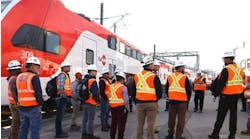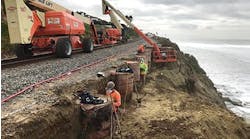Building America’s Future today called for dramatically ramping up long-term investment in our nation's infrastructure after the American Society of Civil Engineers (ASCE) released its 2013 Infrastructure Report Card, which graded America’s infrastructure a D+ overall.
“A report card grade of a D+ is not indicative of a first-class infrastructure,” said Ed Rendell, former Pennsylvania governor and co-chair of Building America’s Future, who spoke at the report card unveiling in Washington, D.C. “For years, we’ve known that our roads and bridges are deteriorating and not keeping up with demand, but this report card shows that America also has substantial deficiencies in our levees, wastewater systems, drinking water systems, aviation and more. For America to stay competitive in a global economy, we must significantly improve our energy, transportation and water systems. ”
The ASCE Infrastructure Report Card is released every four years and this year’s D+ is a slight improvement over the D the nation’s infrastructure earned in 2009. In addition to the overall grade, the report card individually graded 16 different sectors. This year, ACSE assigned between a D- and D+ to 11 of those 16 sectors. Solid waste received the highest grade, at a B- and the nation’s railroads had the most improved grade, rising from a C- to a C+ since the 2009 report card.
“There were some bright spots on the report card, and we applaud those sectors that showed improvement,” Rendell continued. “We’re seeing positive effects of investment in our nation’s rail systems, and we know many cities and states are stepping up to invest more in repair and maintenance of roads, bridges and highways. The president’s stimulus funding also had a short run positive effect. But we urgently need the federal government to set long-term national infrastructure priorities and get serious about funding those critical projects that will allow our economy to thrive and to compete globally.”
Earlier this year, Building America’s Future released its updated report, “Falling Apart and Falling Behind,” drawing attention to America’s decreased ability to compete in the global economy because of our deteriorating highways and bridges, congested aviation systems and insufficient freight systems. In 2005, the World Economic Forum rated the U.S. infrastructure number one in economic competitiveness. Now the U.S. is number 14, in large part because of the issues the ASCE raised in their report card. In its report, Building America’s Future outlined several recommendations for action, including creating a commission to develop a long-term strategic investment plan, passing the Water Resources Development Act (WRDA) and the Realizing America’s Maritime Potential (RAMP) Act, and establishing a National Infrastructure Bank.


